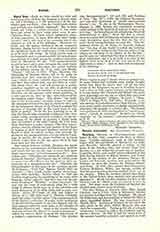

Natal Day.—Both the form natalis (sc. dies/em>) and natalicium were used by the Romans to denote what we call a birthday, i.e. the anniversary of the day when a man was born. Also the Greek words genesia and genethlios or were similarly employed. But in both Greek and Latin a certain extension of this primitive use seems to have taken place even in pre-Christian times. In Latin natalis apparently came, at least sometimes, to mean little more than “anniversary” and it was used of the accession day of the emperor as well as of his birthday. Moreover we know that the games celebrated on an emperor’s birthday during his life, were often continued after his apotheosis upon the anniversary of his birthday as if he were still living. In Greek genesia came to be frequently used in connection with the annual commemoration of a dead person by sacrifices and other rites (cf. Herodotus IV, 26). This commemoration is said to have taken place not upon the anniversary of the day of death but upon the actual birthday of the defunct person (C. I. G. 3417, and Rhode, “Psyche”, 4th ed., I, 235). When, therefore, the Christians of Smyrna about 150 A.D. write to describe how they took up the bones of St. Polycarp “which are more valuable than precious stones and finer than refined gold, and laid them in a suitable place, where the Lord will permit us to gather ourselves together, as we are able, in gladness and joy and to celebrate the birthday of his martyrdom” (Greek: epitelein ten tou marturiou autou emeran genethlion) it is not easy to say how far they were influenced by preexisting pagan usages. This phrase “the birthday of his martyrdom” certainly seems to indicate the commemoration of the day on which he died, and all the subsequent history of the Church confirms the practice of keeping this as the usual feast of any saint or martyr. None the less, knowing as we do that the Greeks also commonly celebrated what they called Greek: nekusia, (commemorative sacrifices), on the anniversary of the death of parents, it would seem that the faithful of the early Church did little more than christianize a pagan custom. This they accomplished, first by offering the holy sacrifice of the Mass in honor of their deceased brethren instead of the blood or flesh of animal victims, and secondly by giving to this commemoration of a true believer’s passage to another life the name Greek: genethlios, or in Latin natalis, rather than to the day upon which he had been born into this world. One cannot however entirely eliminate the doubt whether at the introduction of Christianity Greek: genethlios and natalis had not already come to mean little more than “anniversary” or “commemoration rite”. Tertullian says “oblationes pro defunctis pro nataliciis annua die facimus” (De Corona, cap. 3), which seems to mean “we offer Masses for the dead on their anniversary as a commemoration rite”. Similarly the Chronographer of 354 notes in his calendar against February 22, “VIII Kai. Martias Natale Petri de cathedra”; where natale clearly signifies anniversary rather than birthday. Indeed where we find the Fathers emphasizing the etymology of the word, their language rather suggests that they expected the primary meaning of “birthday” to pass unnoticed. In any case the sense of anniversary alone fits a wide range of phrases which meet us in the calendars and other documents of the fifth, sixth, and seventh centuries. Avitus of Vienne (d. 518) and Eligius of Noyon (d. c. 650) both refer to Maundy Thursday under the name “natalis calicis” (the commemoration of the chalice), a reference, of course, to the institution of the Blessed Sacrament at the Last Supper, and the feast appears under the same name in the calendar of Polemius Silvius of 448. Again in the Leonian Sacramentary we have the phrase “in natali episcoporum”, which the context shows to mean the anniversary of a bishop’s consecration (cf. Probost, “Die Ältesten röm. Sacramentarien”, 124 and 247, and Paulinus of Nola, “Ep. 20”), while the Gelasian Sacramentary uses such expressions as “natale consecrationis diatom”, etc. So also in the Hieronymian Martyrologium (c. 590), besides the constantly recurring natale applied to the festivals of martyrs we have, e.g. on August 2, “In Antiochia natalis reliquiarum Stephani protomartyris et diac.” None the less a certain stress was often laid in Christian sermons and in mortuary inscriptions upon the idea that the day of a man’s death was his birthday to a new life. Thus St. Ambrose (Serm. 57, de Depos. St. Eusebii) declares that “the day of our burial is called our birthday (natalis), because, being set free from the prison of our crimes, we are born to the liberty of the Savior”, and he goes on “wherefore this day is observed as a great celebration, for it is in truth a festival of the highest order to be dead to our vices and to live to righteousness alone.” And we find such inscriptions as the following
PARENTE FILIO MERCURIO FECE RUNT QUI VIXIT ANN V ET MENSES VIII NATUS IN PACE ID FEBR
Where “natus in pace” clearly refers to eternal rest. So again Origen had evidently some similar thought before him when he insists that “of all the holy people in the Scriptures, no one is recorded to have kept a feast or held a great banquet on his birthday. It is only sinners (like Pharaoh and Herod) who make great rejoicings over the day on which they were born into this world below” (Origen, “in Levit.”, “Horn. VIII”, in Migne P.G., XII, 495). Naturally a certain amount of confusion resulted from this use of the same word natalis sometimes to signify natural birth, sometimes the passage to a better life. The former was consequently often distinguished as “natale genuinum”, “natale de nativitate”, the latter as “natale passions” or “de passion”, sometimes abbreviated as N. P.
HERBERT THURSTON

